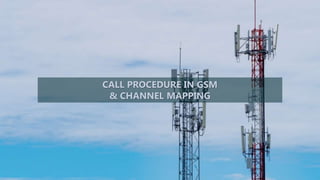
GSM Call Procedure & Channel Mapping Explained
- 1. CALL PROCEDURE IN GSM & CHANNEL MAPPING
- 2. OVERVIEW OF GSM CHANNELING CHANNEL MAPPING Functions and applications of different channels before the call initialization. CALL FLOW From the caller side At the receiver side TABLE OF CONTENTS 2
- 3. 3 GSM Network works in a way that, multiple processes and techniques are going on behind the communication of the calls or the messages using mobile station. There are multiple channels in the GSM application which are different entities, and each channel is used for a specific functions. We are going to discuss that when we call on the GSM network, how those channels are being arranged or mapped and what is the sequence behind when we call the other GSM subscriber. GSM OVERVIEW
- 4. 4 CHANNEL MAPPING When the cell phone is turned on and the sim is inserted, the MS initializes the linking with the FCCH channel to be able to sync itself with a carrier frequency, in order to establish a link with BTS make a call any moment. In next step, the MS links to SCH synchronization channel, this channel gives the information about the sync available in time slots or TDMA frame structure and assign us the temporary channel. BCCH broadcast channel gets active, basically this channel looks for the information about other cells which are outside BTS, our location areas, ranges of the frequencies that can we use, and output power channel can hold. Then the PCH paging channel continuously links with our MS to check the incoming dial. If MS detects the incoming message its request the RACH channel to gran the access to that link to acknowledge the call.
- 5. 5 CHANNEL MAPPING ..2 The MS will be provided the access through the AGCH, which also tells the MS which SDCCH is to use for call. Along with grant access to call, the SACCH is also activated which tracks the call and tells information about call timing, delay and output power etc. Then the MS in linked to the TCH transmission control channel by the same SDCCH, the TCH tsk is to figure the whether the half rate is available or the full rate, it tunes MS accordingly, and the rate tuning can be altered during the call for efficiency.
- 6. CALLING FLOW at caller 6 This process starts with the Mobile Station MS communicating through electromagnetic signal with nearest BTS and request a random-access channel RACH to enter the cellular network MS - BTS Once the channel is eing granted, The BSC allocates the traffic channel which allows the MS to send the recipiets, mobile number stored in call message through BSC to main hub MSC at the caller side. BTS - BSC On arrival, the call is put on hold as the subscribers' details are validated using few departments that posse's different information about the caller and the recipient. SC - MSC The VLR Visitor Location Register, checks the subscriber information like Balance credit and the services user have access to by using IMSI International Mobile Subscriber Identity. VLR - HLR Then MSC verifies the device details related to security purpose in EIR Equipment Identity Register, those parameters contains, whether the device is Blacklisted, Whitelisted or Gray listed. HLR - EIR EIR - AUC After the device is verified, now the Authentication Centre AUC is used to verify each sim card through IMEI that tries to make call on the GSM through IMEI
- 7. CALLING FLOW at receiver 7 The MSC caller will send all the gathered information about the subscriber to the MSC receiver. After sharing subscriber information, both the MSCs ebstablish uplink and downlink channel for call. Now the Reciever is identified by his or her unique Caller ID or MSN Mobile Subscriber Number. The connection or communication is established between the MSCr and MSCc Then the same protocol is being followed by MSC receiver for the verification of the user who is being called. VLR > HLR > EIR > AUC. The MSC receiver at the same time is linked with the BSC receiver to BTS Receiver and the Mobile Station at the end.
- 8. CALLING FLOW cont… 8 This whole process happens every time, whether the recipient phone is off, not in range or in busy at another call. In the best-case scenario, the user’s phone rings and the acknlowledgement is being sent to the MS caller and phone continoues to go live until call disconnection acknowledge message receives. After the call ended, the allocated channel goes idle again and ready for the next call or another user calling.
